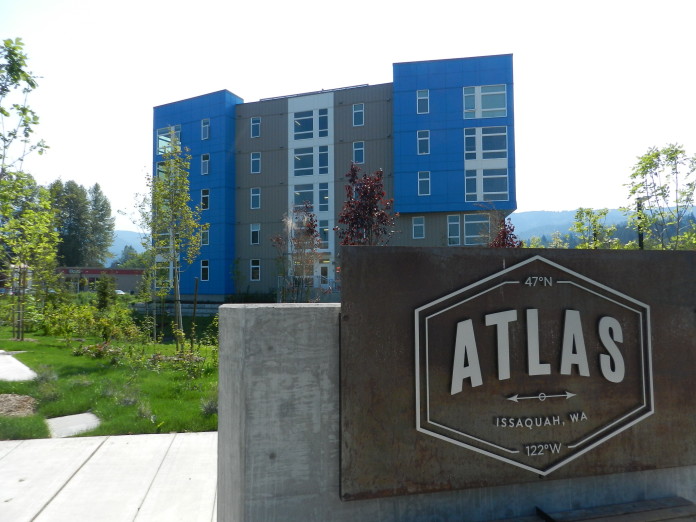
From the mansionization of Mercer Island to the immolation of Issaquah’s quality of life, across the Pacific Northwest the hills are alive with the sound of destruction
By Mark Cromer
It’s a late August afternoon and I am watching the traffic stream down Issaquah-Pine Lake Road toward its juncture at Issaquah-Fall City Road, where drivers can either peel off toward the center of town or keep going to the Issaquah Highlands.
The long convoy seems to roll on across a landscape that once epitomized the sublime pleasure of country living but is now in state of transition—or perhaps degeneration is more like it.
As a second-generation Southern Californian, in every passing car, SUV and oversized pickup truck I recognize the symptoms of the plague that eventually killed the quality of life for most of the residents in the Golden State. I know what the long streams of traffic represent, with each vehicle looking like cancer cells creeping along an increasingly clogged artery, moving between the tumors that are now sprouting across Northern Washington.
The Weapon of Mass Development is exploding in the Evergreen State to deadly effect.
Having spent much of the past three years in Issaquah, Bellevue and the surrounding communities, I’ve watched the pace, style and dynamic of development unfold in a manner that is strikingly reminiscent of the orgy of building that convulsed across and eventually consumed Southern California.
Standing in front of a growth of new homes in Sammamish that have been appropriately baptized with the now required euphemistic name, in this case ‘Symphony Ridge,’ I am once more struck by the Satanic majesty that shines bright when developers strip a hillside of trees and gut its flora to paint it over with cracker box homes jammed together and then sell it as a slice of the quality of life that they just killed a little more.
As it was in Southern California, the verdant pastures and tree-carpeted mountainsides of Northern Washington have been sentenced to die by a thousand cuts that are slashed gleefully across them with one development after another as new construction no longer unfolds slowly across decades, but now rapidly unspools over the once rural landscape year after year and in many places, month after month. Towering high-density developments and ‘master planned’ communities have appeared like melanoma along Interstate 90 between Seattle and the Snoqualmie Pass, with once bucolic small towns like Issaquah, Snoqualmie, Sammamish and Carnation bearing the brunt of ground-breakings that are accelerating in a pace that’s driven by its own self-perpetuating momentum and abetted by municipal governments long succored on the developers’ teat and tutored in civic madrassas that hold one truth sacred above all others: Growth is Good.
And thus development begets development begets development.
In June, Sammamish Councilman Tom Hornish told a reporter for The Sammamish Review that ‘urban growth is what the city has to do, but admitted that he was still trying to figure out what responsible growth should look like in Sammamish.’ And there it is: Urban growth is what the city has to do. Hornish believes there is simply no other way, no other choice to be considered and no other option to pursue. Growth simply has to happen. More people. More cars. More homes. Period.
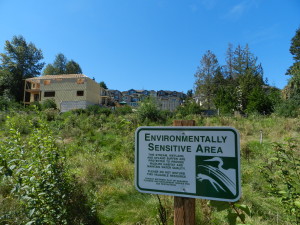
As is often the case in such manmade tragedies, there are moments of darkly comic relief to be found, like the perverse absurdity on display at Symphony Ridge, where a tiny sign has been planted in a small greenbelt in front of the new homes that now flow down the hillside, advising “Environmentally Sensitive Area: This stream, wetland and upland buffer are protected to provide wildlife habitat and maintain water quality. Please do not disturb this valuable resource.” Along with the copy is an illustration of a silhouetted leaping frog, willows and a bird.
That’s pretty much what passes these days as being eco-friendly, a fractional remnant of wild land repackaged and promoted with a small sign as protected green space that allows both City Hall and the developers to dress up and play make-believe as partners-in-progress and trusted stewards of a community’s natural heritage—when in fact it’s just another installment in the ongoing brutal gang rape of Mother Nature and the self-immolation of communities that managed to sleep through their (sub)urbanization until the backhoe was across the street.
Symphony Ridge is being built by Benchmark Communities, which is a subsidiary of the publicly traded developer giant Union Community Partners, and it shows. On its website the company gloats “UCP is a homebuilder and land developer with significant land acquisition and entitlement expertise in high-barrier-to-entry West Coast…markets characterized by attractive residential real estate fundamentals. We operate in regions that boast favorable demographic trends and positive economic indicators within Northern & Southern California [and] the Puget Sound area of Washington state…”
High-barrier-to-entry West Coast markets? Northern Washington should be so lucky.
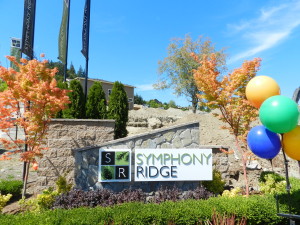
When was the last time a significant developer faced a ‘high barrier’ in the markets that UCP swims in? The average homeowner looking to get a code variance to build a backyard retainer wall six inches higher than allowed likely faces more opposition from the local planning commission and city council than commercial builders do when they’re looking to tear into a mountainside with a 1,000-unit development evinced with all the aplomb of hyenas ripping a fallen water buffalo to pieces on the Serengeti (apologies to the hyenas).
While the ballot is still actually more powerful than the billfold, the end result is based entirely on who turns out and when. And the good people in small towns across Northern Washington are apparently just now waking up to discover—quite frankly too late—that they don’t get much of a do-over this far down the road. Two lane blacktops that are increasingly jammed with traffic will not thin out anytime soon, but will likely coagulate into a more deeply settled vehicular sludge as building continues to outstrip the infrastructure required to support it.
In Issaquah, the city council long ago green-lighted a series of massive developments under its ‘Central Issaquah Plan’ that will explode the town’s population and the drastic day-to-day impacts that escalating population will bring, but they didn’t do it in secret meetings conducted under the cover of darkness. No, they did it under the dull florescent glow of the lights at City Hall in planning policy commission meetings and during city council meetings that probably had more tumbleweeds blowing through them than residents attending. A largely anemic and anesthetized resident population is one of the critical components of civic life developers’ play to their advantage.
The council’s plan to detonate a population bomb in central Issaquah, blowing it up from 750 homes to 8,500 residences, was well documented in the press but the tsunami sirens went unheeded.
And thus on the northeast corner of 7th Avenue and Gilman Boulevard in the town center rose a sprawling five-story apartment complex christened Atlas, a garish cubist growth that’s marketed with the brand line of ‘Modern Apartments, Great Outdoors.’ Though it stands in stark contrast with the character of what is now fast becoming old Issaquah, Atlas stands triumphant as a preview, a coming attractions of sorts, for what developers have in the pipeline and on the planning boards across the region.
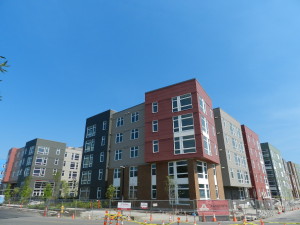
As I stand inside the secure, air-conditioned lobby of one of the Atlas buildings’ leasing office, I find myself impressed by the sheer sterility of its interior, as soulless on the inside as the complex appears from the exterior. A young, tattooed blonde leasing agent advises me that Atlas offers 72 floor plans to choose from and the two-bedroom units start at $2,400 a month, with leases offered on eight to 13 month installments. When I inquire as to whether two or three-year leases were available, she seemed perplexed and surprised.
“Oh goodness no,” she said. “We’d never offer anything past 13 months. Who would want that?”
“People who want to commit to a three year lease at a fixed monthly rent,” I replied.
Her bewilderment slipped away into a mild tone of perturbed. “Again, we offer leases for eight to 13 months.”
As I walked back outside I was struck by the slick marketing one-sheet she had given me, which advertised “Escape to Issaquah and discover Atlas—a higher quality of living. Well-planned apartment homes are spacious, efficient and designed to compliment your Northwest lifestyle” and was illustrated with pictures of lush, wild land and Lake Sammamish as well as a young couple with their child cozy on a couch, a chromed out kitchen, a mountain biker on a forest trail, hikers and a warmly lit but empty bar that just beckons. Atlas is clearly marketing to the Millennial-aged workers that are filling out the tech jobs that have grown neighboring Bellevue’s skyline into a glittering vertical spur of Seattle, something akin to the Westside in Los Angeles.
But then I am hit again by the actual reality of that Northwest lifestyle on this part of town as soon as I walk out of the building; the slow churn of traffic on Gilman Boulevard and pissed off drivers swerving onto 7th Avenue, which is still essentially a side street but now has a massive multi-family housing development jammed alongside it, and of course the ‘Great Outdoors’ that unfolds across the avenue from Atlas: a vast sprawl called the Issaquah Commons filled with such natural treasures as REI, Safeway, Ross (For Less), Chiplote, Five Guys, Tutta Bella, Wildfin and, of course, Starbucks.
Two years ago, before Atlas arose, I marveled how coming down 12th Avenue during workday mornings from Tibbetts Creek Valley into town slowed from cruising speed to a crawl as soon as one turned from Maple Street onto 17th Avenue, just a few blocks from the I-90. In shades of LA, one could sit on 17th watching lights change and change again while only moving two or three car lengths, a reoccurring nightmare that could last fifteen or more minutes to finally make it to the westbound I-90, and then roll the nine miles into Mercer Island sometimes in 20 minutes, sometimes in 30 minutes and sometimes even longer.
A half-hour or more to cover a little over nine miles, the new normal.
And just like in LA, ‘the 405’ here too is synonymous with a cluster bang, even for those drivers that don’t need to transition onto it, with the backup from its juncture at the I-90 clogging westbound lanes across the interstate.
Into this landscape Atlas was born. And more such monstrosities are on the way.
In July, Issaquah Mayor Fred Butler announced during a community open house held over a toddler killed on busy Newport Way that a once magnificent green pasture dotted by little more than a few old sheds with moss-covered roofs were to be the near-future home of a new 18-building, 400-unit multi-family development dubbed Issaquah Gateway Apartments. In real terms, that’s 2,000 or more people and 600-plus vehicles jammed into an already strangulated corner of the town. But then again, who’s really counting? Certainly not City Hall. Two other multi-family developments totaling more than 200-units are also planned in central Issaquah just blocks from Atlas.
One can almost imagine the planning sessions as the crack pipe of new project plans gets passed around the table, with developers pacing around behind the commission members like impatient dealers exhorting ‘Now hit that shit! Man-up and hit that shit. The glass pipe is singing your song, baby, Number One with a bullet and it’s called: hit that shit!’
On Mercer Island, the still semi-sleepy community of 25,000 people on Lake Washington, the rumble of demolitions and development has been perpetual for the past three years at least, in another ongoing civic makeover that has its roots in Los Angeles as well. Once dotted primarily with small cottages and quaint single-family homes on spacious lots with front and backyards, natural landscaping and breathable easements between dwellings, the trend here over the past few years has seen developers snap up old homes, tear them down, and raise McMansions in their place or max out vacant lots with jutting boxes. A few years ago I started walking the epically long staircase that snakes up the hillside above Mercerdale Park and zig-zagging through the neighborhoods along what had been quiet streets lined with comfortable homes, but quickly noticed the jarring sight of new homes that were completely out of scale and character for the island.
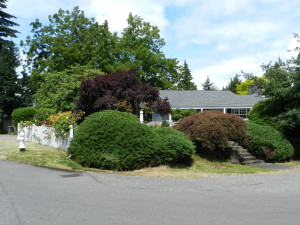
One afternoon I was photographing some of the development that was going on and an older woman emerged from her rationally-sized home—one of the original residences on the block—to ask if I was with a realtor or developer. I explained that I was a writer and that my girlfriend worked on the island and we enjoyed exploring it and that I was struck by the rash of development I encountered, and how it reminded me of what had happened throughout many neighborhoods in Los Angeles that resulted in the destruction of their historical nature and their charming character. I told her I was thinking about writing about it.
She told me that she had moved onto the island in the 1960s, bought her home and had long ago paid it off and was now retired and looking forward to living out the rest of her not too many remaining years there, but that as many as six or seven times a year for the past few years developers landed on her doorstep with unsolicited offers in hand.
“They want my house just so they can tear it down,” she said, visibly disgusted by the thought. “They’ve made me some pretty amazing offers, far more than I ever paid into it or could have imagined back then, but the thing of it is that even with all that cash in hand I wouldn’t be able to afford to buy another nice home on the island today. I’d have to move somewhere else. And I don’t want to go anywhere else.”
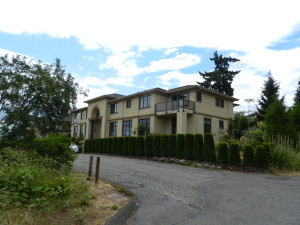
Last month as I walked through Aubrey Davis Park, the thin greenway the city laid across the top of the I-90 tunnel on the Seattle-side of the island, naming it after the former mayor of Mercer Island who famously remarked of the interstate “We don’t want to see it. We don’t want to hear it. We don’t want to smell it,” I spoke with a local named Matt, a more recent arrival on the island who was out walking his chocolate Labrador suitably named ‘Rufus.’ He tells me that he and his wife moved to the island from Snohomish a few years ago and have been struck by the pace of changes they’ve witnessed since even then.
“They’re pouring people into the north side of the island with high-density projects but without the infrastructure to support it,” he said. “It can’t continue, that’s certain, but how we can sustain what’s already being developed now remains to be seen.”
Matt said that the council, which he describes as having been “taken over by developers,” claims that by maxing out multi-family housing on the north end of the island they will be able to preserve the more rural aspects of island living to the south. “We’ll see if that proves to be true once they’re done up here,” he said. But Matt also noted that he and his wife had bought two homes on the island and planned on unloading one when the time and the price was ripe.
“I guess we’re hoping to be among those profiting from all this,” he said with a shrug and slight grin. “What are ya gonna do?”
Well, make a bundle, it would seem.
A few days later I find myself at a sidewalk table in front of the H&H Saloon on Front Street in the old downtown of Issaquah, enjoying a solid pour and a smoke and watching the cars crawl by in a near glacial drift that allows drivers to focus more on their phones than actually driving. It’s not quite 3 p.m. on a weekday and yet the main vein in downtown is already bumper-to-bumper. It has been this way for awhile now, since before I started hanging out here three years ago, and it’s not going to get better—only worse.
And I marvel how most everyone here knows this, the vast majority oppose it and yet the cycle continues to repeat itself in Issaquah and across Northern Washington just as surely as it did throughout Southern California, with the gluttony of development devouring fine landscapes and more simple lifestyles to replace them with new landscapes that are a cheap veneer of what once was and new lifestyles that are more coping strategies than a freedom of actual being.
Old Issaquah on Front Street will eventually be transformed from a small town haven, an authentic outpost whose simple brilliance reflected the true country living around it, into a cheap and crowded knock-off as real estate investment firms gobble it up, jack up the rents to run out iconic joints like the H&H Saloon and the Rolling Log Tavern that’s nestled just down the road on Sunset Way and replace them with another gastro pub, a chic bistro or a chain brand bar that serves craft spirits with a jigger or a fucking fixed trigger pour to the smart phone, wet-nursed dilettantes that mistake a $13 drink for a proper one.
I keep thinking back to the Sammamish tumor Symphony Ridge and how the developer Benchmark Communities adorned the signage in front of their housing growth with outsized fake balloons like a sardonic wink from the creepy clowns wearing Armani suits instead of polka dot vests.
Pennywise surely sends his regards.
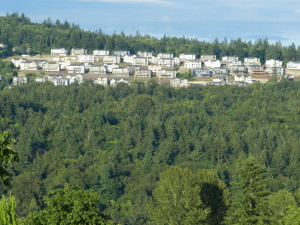
Last week, facing a public maelstrom over the explosive developments in central Issaquah that have brought gridlock to its city streets while fundamentally altering the town’s character, the City Council proposed an ‘emergency ordinance’ that would trigger an immediate six-month moratorium on all new construction bids—but would stop nothing that is already under construction or even been through the permit process.
Again, it’s far too little, years too late and almost certainly nothing more than an empty deflection by the council designed to merely buy time and let things settle down and cool off among the angry villagers, who no longer gather in the commons amid the glow of torches holding pitchforks as they once did in the days of yore.
The council knows that ‘speaking truth to power’ is a sad goof that doesn’t mean shit. Only when people start speaking power to power at the ballot box will things actually change, and don’t count on that anytime soon.
When the coast is clear once more, be it next spring or next fall or the summer of 2018, the bulldozers will return—if they ever leave—and the chainsaws will roar to life once more as the red tide of humankind pushes ever onward.
So drink up, beautiful Washington, for the check has been laid on the table and it’s time to pay.










